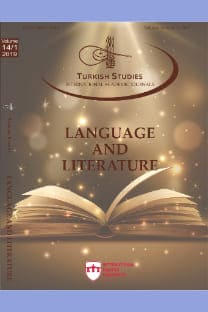Çeviri Salt Bir Aktarım Mıdır?” Sorusu Ekseninde Bireysel Bir Yorumlama Süreci Olarak Çeviri
Translation as an Individual Interpretation Process on the Basis of the Question of “Is “Translation Purely A Transfer?
___
- Ciuk, S. & James P. (2015). Interlingual translation and the transfer of value-infused practices: an in-depth qualitative exploration, Management Learning, 46(5), 565–58. “Collective consciousness”, https://csmt.uchicago.edu/glossary2004/collectiveconsciousness.htm Erişim: 05.02.2021
- “Hermeneutics”, https://www.oxfordbibliographies.com/view/document/obo-9780195396577/obo9780195396577-0054.xml Erişim: 07.03.2021. “Çeviri”, https://sozluk.gov.tr/ Erişim: 29.01.2021 “Masa”, https://sozluk.gov.tr/ Erişim: 29.01.2021
- Köktürk, Ş. (2015). Uygulamalı çeviribilim, Detay Yayıncılık.
- Kotlu, E. (2007), Yapısalcı ve post-yapısalcı sosyal teoride dil (Sosyal teoride bir model olarak dil [Yayımlanmamış yüksek lisans tezi]. Aydın Adnan Menderes Üniversitesi, Sosyal Bilimler Enstitüsü.
- Lefevere, A. (1992). Translation, rewriting, and the manipulation of literary fame, Routledge.
- Saussure, F. (1959), Course in general linguistics (çev. Wade Baskin= New York, Philosophical Library. http://faculty.smu.edu/dfoster/cf3324/saussure.htm Erişim: 07.03.2021.
- Snell-Hornby, M. (2006). The Turns of translation studies: new paradigms or shifting viewpoints?, John Benjamins Publishing.
- Stolze, R. (2013). Çeviri kuramları: giriş, (Çev. Emra Durukan), Değişim Yayınları. “Yorumlama”, https://www.nedirnedemek.com/yorumlama-ne-demek Erişim:02.02.2021.
- Yücel, F. (2007), Tarihsel ve kuramsal açıdan çeviri edimi, Dost Kitabevi.
- Venuti, L. (2008). The Translator's invisibility: a history of translation, Routledge.
- Wang L. & Sin K. K. (2011). Toward a clarification of the concept of cultural transfer in legal translation, International Journal of Law, Language & Discourse, 66-100.
- http://www.ontodergisi.com/saussureun-dil-bilimidusuncesi/#:~:text=G%C3%B6steren%2C%20bir%20ses%20imgesidir%3B%20g%C3%B 6sterilen,(g%C3%B6steren)%20bir%20araya%20getirirler. Erişim: 07.02.2021
- ISSN: 2667-5641
- Yayın Aralığı: 4
- Başlangıç: 2006
- Yayıncı: ASOS Eğitim Bilişim Danışmanlık Otomasyon Yayıncılık Reklam Sanayi ve Ticaret LTD ŞTİ
Bestelenen Şiirlerin İz Düşümü ve Klasik Türk Şiirinde Mutribin Sazından Şiirler
Ahmet Hamdi Tanpınar’da Edebiyat, Muhyiddin İbn’ül Arabî’de Felsefe: Kadın
Unveiling the Translation Procedures of Fantastic Items and Names in Children’s Literature
Françoise Sagan’ın Hoş Geldin Hüzün Adlı Romanında Elektra Kompleksi’nin İzleri
Ümran TÜRKYILMAZ, Umre Gül Nuevo BOO
XVI. Yüzyılda Edirne’de Yaşanan Taşkınlar Üzerine Bir Araştırma
Yatay Dünya Tedavisi” ile Covid Salgınından Temelli Kurtulma Projesi: Koronapolisler
Çeviri Teknolojileri Bağlamında Geçen Terimlerin Türkçe Karşılıklarının İncelenmesi
Geç Osmanlı Toplumunda Sünnet, Tıp ve Erkekliğin Toplumsal İnşası (1872-1922)
